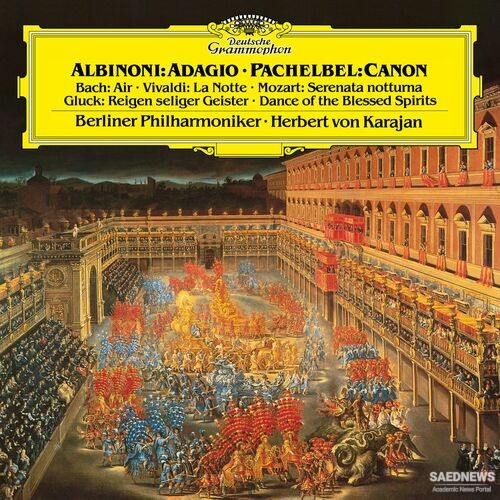Bracketed by Buxtehude to the north and Froberger to the south, the German heartland finally produced in Johann Pachelbel (1653–1706) a first-rate composer. Active in Erfurt and Nuremburg during the 1680s and 1690s, Pachelbel had studied in Vienna, but was also acquainted with Buxtehude’s works. In 1699 he dedicated his Hexachordum Apollinis (figural variations) jointly to Buxtehude in Lübeck and F. T. Richter, imperial organist in Vienna. Pachelbel wrote big toccatas like those of Buxtehude, but the rhapsodic figuration tended to harden into cooler, if still brilliant, forms. Pachelbel seemed more at home in his shorter toccatas with prominent pedal points, each ten or twenty measures long, only two or three running through a whole piece. These shorter toccatas were like intonations (a function toccatas had once had), having only one idea. In general, Pachelbel tended away from long, sectional works to shorter, homogeneous ones.
Most characteristic of Pachelbel are his numerous fugues. Some of these could be called Capriccios, canzonas, or fantasias, direct descendants of Frescobaldi and Froberger; but Pachelbel’s fugues usually have only one section with continuous treatment of the single subject from beginning to end. Pachelbel favored lively subjects, often with repeated sixteenth notes. The continuous treatment of such subjects brought about a uniform rhythmic motion throughout the fugue. Pachelbel tended to write this smooth, fugal counterpoint whenever he was not writing a toccata with obviously figural ornamentation over a pedal. He used fugal style extensively for intonations. Apparently he liked these compact pieces based on strictly imitative style, for he wrote some ninety-four of them as Magnificat intonations for all the modes. One for hypophrygian on E (these intonations are for a mode but —like Gaultier’s lute pieces—in a key) is given in Example 84. The expression of Pachelbel’s great lyric gift through smooth harmonic progressions illustrated in these fugal intonations indicates a stage of development in German organ music analogous to the development of the Italian aria in Cesti.

Alongside Pachelbel’s fugues, his chorale preludes were equally important models for the next generation. Of the several types Pachelbel cultivated, two are most frequent. One is a genuine prelude, an intonation for the singing of the chorale; it consists of continuous imitative treatment of the first line of the chorale. The second type begins like the first, and then proceeds to a complete statement of the chorale melody, often in the top voice in longer notes, accompanied neither by imitation nor figural patterns but by suavely animated chords. Here Pachelbel’s sensitivity to harmony can best be studied. Two preludes on Ach Herr, mich armen Sünder (the “Passion” chorale) illustrate the two types described.
Usually Pachelbel presents the chorale in merely beautiful harmonies, without commenting musically upon its emotional significance. Sometimes, however, he writes a chorale prelude clearly descriptive of the meaning of the chorale text. Warum betrübst du dich, mein Herz (Why art thou so troubled, my soul?) expresses in its extended cadenza the dark, brooding atmosphere of the text. This stress on the character of a particular chorale, analogous to the growing character of arias after 1680, indicated the future development of chorale preludes—indeed, of all German sacred music in the decades to come.
The same tendency toward character found unique expression in a set of chamber sonatas for violin (ca 1674) by the south German virtuoso Heinrich Biber (1644–1704). Although cast in familiar forms and styles (allemande, courante, ciacona), each of Biber’s fifteen sonatas has a strong sense of character; each is given specific content by being associated with one of the fifteen episodes in the lives of Jesus and Mary that are included in the rosary. This cycle of meditations on the sacred mysteries, a devotional practice that became popular during the 1600s, infused emotional character into Biber’s sonatas, which are usually called the “Mystery” sonatas.


 Johann Jakob Froberger
Johann Jakob Froberger














































